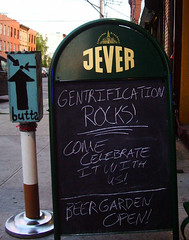Where's the fire?
(Flickr photo by elevated primate.)
DC1974 sent me a copy of "The Embers of Gentrification," about the Red Hook District in Brooklyn, from from New York Magazine.
Frozen Tropics has also blogged the story.
The content is pretty good, discussing the various types of people who move into and change a neighborhood. But I think the headline is a bit misleading.
If people expect that a revitalizing neighborhood changes overnight, they are sadly mistaken. It takes decades. I moved to DC in 1987, and ever since 1980 people had been saying Logan Circle was on the brink of improvement. It finally happened about 2001-2002. (Even in 1987 houses cost more than $300,000 though.) The same with many other neighborhoods. It takes a long long time.
And when the energy is in part stoked by realtors, renovators, big companies, media, etc., changes in the economics experienced by any one of these segments will impact the current trajectory. A lot of the buying demand in hot places is investor driven (as much as 25%) and in cities like NYC, people buying pied a terres and vacation places. And this market is impacted by the mortgage market.
In the face of the current mortgage meltdown, people have forgotten that in a way, the entire building boom in the period of 2000-2007 has been constructed on a weak economy. The reason that mortgage rates were so low is because the demand for loans was low overall, hence low rates. As demand for money increases, interest rates increase. This would reduce the number of loans generated.
Certain parts of the industry, needing to still make loans to stay in business, lowered their credit standards in response, to maintain production. At some point, they were going to make a fair number of loans to people who weren't well prepared to weather economic downturn, and the problems would redound to the lenders. That's what happened.
It's not really about the "gentrification" movement having its own sustainable momentum, it's about the investment process, who invests and why, and the time frame in which people expect for the investment to pay off. Places that are well located will do well. Transit access, amenities, etc. are what make the difference between neighborhoods that improve vs. those that remain stagnant.
Also see this collection of newspaper articles and photos on Red Hook from Wired New York.
And these pieces from the Times of London, referencing the work on super gentrification, by Loretta Lees, "There's plain gentrification ... and then you have Islington," and "No chance of closing the class gap now," and her paper, Super-gentrification: The Case of Brooklyn Heights, New York City.
Labels: gentrification, neighborhood change




1 Comments:
very interesting blog,nice information.your work is very excellent.
Post a Comment
<< Home